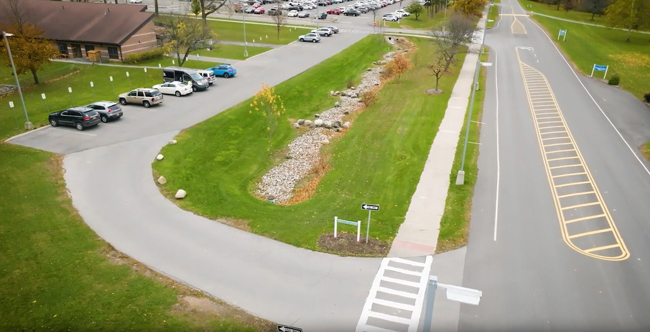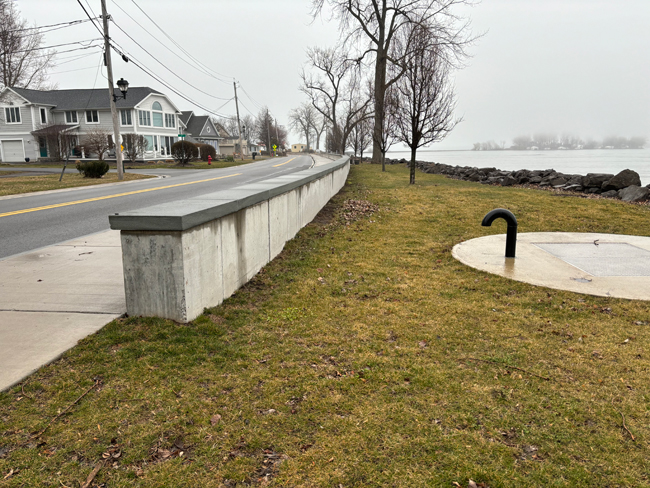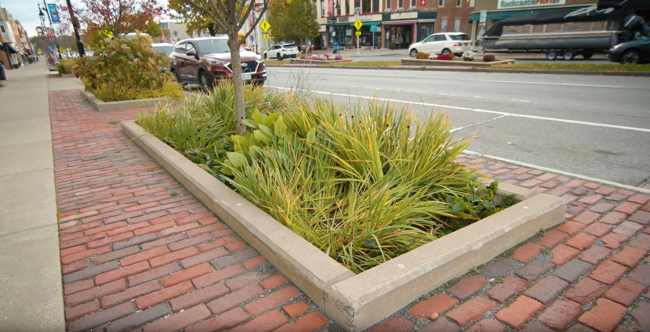
A bioretention feature to manage stormwater in the City of Canandaigua. Credit: New York Sea Grant/Roy Widrig
Sodus Point, Canandaigua, Geneva, Finger Lakes Community College Showcase Green Infrastructure for Stormwater Management
Contacts:
Mary Austerman, Great Lakes Coastal Community Specialist, E: mp357@cornell.edu, P: 315-331-8415
Roy Widrig, Great Lakes Coastal Processes and Hazards Specialist, E: rlw294@cornell.edu, P: 315-312-3042
Kara Lynn Dunn, NYSG's Freelance Great Lakes Publicist, E: karalynn@gisco.net, P: (315) 465-7578
Newark, NY, March 11, 2024 - New York Sea Grant has announced a “Great Lakes Resilience Case Studies” video series featuring successful green infrastructure and flood resilience projects in three upstate communities.
The videos, which are featured below, highlight approaches and design elements applied in Canandaigua, Geneva, and Sodus Point that other communities statewide can use to protect water quality, reduce the impact of flooding, and enhance shoreline integrity.

This flood wall installed along Wickham Boulevard overlooking Sodus Bay in Sodus Point, New York, has reduced roadway flooding. Credit: New York Sea Grant/Mary Austerman
Sodus Point is the village with the lowest elevation along Lake Ontario’s southern shoreline. Following the high-water event in 2017, the Village of Sodus Point enlisted New York Sea Grant to facilitate a public engagement process that empowered local officials to identify ways to protect the village from future flooding. In the “Sodus Point’s Flood Resilience: A Case Study in Community Strength” video, Sodus Point Mayor Dave McDowell, resident Laurie Hayden, and Sarah Costich of Costich Engineering, Land Surveying & Landscape Architecture share how installing green infrastructure elements, a larger storm sewer system, flood wall, and sand dune have benefited the village.

This median planting is a green infrastructure installation in the City of Canandaigua. Credit: New York Sea Grant/Roy Widrig
The “Protecting Our Water Resources: A Case Study in Green Infrastructure” video illustrates a sampling of green infrastructure (GI) practices and how they can be used to mitigate problematic stormwater. The short video showcases GI practices, such as bioswales, green streetscaping, rain gardens, and porous pavement, applied in the cities of Canandaigua and Geneva to retain and filter stormwater during heavy rain events to reduce nuisance flooding. Porous pavement at Finger Lakes Community College (FLCC) has reduced water pooling in previously soggy areas near the CMAC Performing Arts Center on campus. In the video, Canandaigua City Manager John Goodwin, FLCC Director of Facilities and Grounds Catherine Ahern, and Barton and Loguidice Senior Managing Community Planner Jayme Breschard encourage other communities to explore green infrastructure as a feasible component to stormwater management.
“These video case studies demonstrate how communities have addressed local needs and taken action to improve their resilience to flooding. New York Sea Grant is pleased to be able to create these videos to showcase the work of local communities, and to provide them as a resource to other communities as they start their own journeys toward improved flood resilience,” said New York Sea Grant Coastal Community Specialist Mary Austerman.
Funding for the case study videos development was provided through the National Sea Grant College Program of the U.S. Department of Commerce’s National Oceanic and Atmospheric Administration to the Research Foundation of the State University of New York, and through the Federal Emergency Management Agency of the U.S. Department of Homeland Security to Cornell University on behalf of New York Sea Grant.
On YouTube: 2024 Great Lakes Resilience Video Case Studies
A new video case study series from New York Sea Grant explores Great Lakes topics including resilience, green infrastructure, and the freshwater system's watershed.
Sodus Point's Flood Resilience: A Case Study In Community Strength
In 2017, Sodus Point saw its first high water year that it had in a long time. As explored in this first video in a 2024 Great Lakes resilience series from New York Sea Grant, Sodus point is the lowest village, elevation wise, on the south shore of Lake Ontario. That's why there was so much attention and why the village had so much difficulty.
"I wish prior to '17 we had been able to have the workshop that we had that Sea Grant put on to evaluate how to best protect the village," said Dave McDowell, Mayor, Village of Sodus Point. "The village, in implementing all of the resiliency projects, it's given a new lease on life for this whole community."
Protecting Our Water Resources: A Case Study in Green Infrastructure
Protecting our water quality is paramount to our overall quality of life. So in order to do that, we need to make sure the water that goes into that lake is as good a quality as it can be.
That's where green infrastructure comes in.
Green infrastructure is a design solution to reduce vulnerability for communities for flooding and water
quantity and quality issues.
Most people don't even realize the benefits that green infrastructure provides for stormwater management.
If you're doing it right, green infrastructure features like bioswales and rain gardens usually are hidden in plain sight.
Understanding the Great Lakes Watershed
The Great Lakes Watershed is a complex geological and biological system, supporting countless communities, ecosystems, and economies.
As explored in this second video in a 2024 Great Lakes resilience series from New York Sea Grant, to understand the importance of it all, we must begin with the simple question: What is a watershed?
The Great Lakes Watershed includes two distinct regions, the Upper Great Lakes, and the Lake Ontario St. Lawrence River System.
Understanding watershed dynamics is important for managing water resources, understanding flooding, preventing pollution, and protecting aquatic ecosystems.
Understanding How Water Moves Through the Great Lakes
Oswego, NY, February 5, 2024 - How does water travel through the Great Lakes Watershed to the Atlantic Ocean?
Journey with us in this third video in a 2024 Great Lakes resilience series from New York Sea Grant as we follow the path of a single drop of rain that falls into Lake Superior and makes its way through the Great Lakes.
Understanding how water enters and leaves the Great Lakes is important when thinking about the limitations of water level regulation in Lake Ontario, water movement through the system, and how the Upper Great Lakes can influence Lakes Erie and Ontario.
For more, see NYSG's "Coastal Communities Development" resource site, www.nyseagrant.org/ccd, and "Great Lakes Coastal Processes and Erosion" resource site, www.nyseagrant.org/glcoastal.
More Info: New York Sea Grant
New York Sea Grant (NYSG), a cooperative program of Cornell University
and the State University of New York (SUNY), is one of 34 university-based
programs under the National Oceanic and Atmospheric Administration’s
National Sea Grant College Program.
Since 1971, NYSG has represented a statewide network of integrated
research, education and extension services promoting coastal community
economic vitality, environmental sustainability and citizen awareness
and understanding about the State’s marine and Great Lakes resources.
Through NYSG’s efforts, the combined talents of university scientists
and extension specialists help develop and transfer science-based
information to many coastal user groups—businesses and industries,
federal, state and local government decision-makers and agency managers,
educators, the media and the interested public.
The program maintains Great Lakes offices at Cornell University, SUNY
Buffalo, SUNY Oswego and the Wayne County Cooperative Extension office
in Newark. In the State's marine waters, NYSG has offices at Stony Brook
University and with Cornell Cooperative Extension of Nassau County on Long Island, Brooklyn College and Cornell Cooperative
Extension in NYC and Kingston in the Hudson Valley.
For updates on Sea Grant activities: www.nyseagrant.org has RSS, Facebook, Twitter, Instagram, and YouTube links. NYSG offers a free e-list sign up via www.nyseagrant.org/nycoastlines for its flagship publication, NY Coastlines/Currents, which is published quarterly.